Contents
The causes and treatment of tomato chlorosis is the issue that most often worries gardeners during the cultivation of this vegetable crop. Since it is this ailment that usually manifests itself first on her bushes. It occurs due to improper agricultural practices or non-compliance with care recommendations, but if it is detected on time and treatment is started immediately, it is quite possible to get rid of it.

In order for the treatment of chlorosis to be effective, it is necessary to correctly determine the cause of its occurrence.
Can there be chlorosis on tomatoes
Chlorosis is a common disease that affects many crops, and tomatoes are no exception. It can be found on plants cultivated in the open field, as well as in greenhouse conditions. Often the disease is reversible, and if the bushes are slightly affected, they can be cured and the crop saved.
What is dangerous chlorosis
Treatment of the disease chlorosis on tomatoes, the photo and description of which are presented below, should be carried out immediately after its discovery, since it creates a rather great danger to the culture. In the case when the disease is non-infectious in nature, the plant can almost always be saved. Although if you start the disease, the culture bushes will greatly weaken and practically stop bearing fruit. In addition, the tomatoes will become tasteless, watery and small.
In the case when tomatoes become infected with viral chlorosis, it is almost impossible to save them. The right decision would be to remove all the bushes from the garden and disinfect the soil.
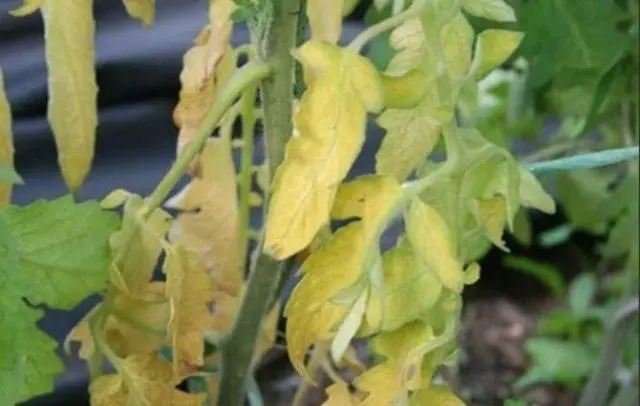
The viral type of the disease is considered the most dangerous for plants.
Signs of the appearance of chlorosis in tomatoes
According to the main signs of chlorosis of tomatoes and their seedlings, the causes, treatment and type of the disease are identified. Although it has several varieties, the symptoms are usually the same.
These include:
- shredding and yellowing of tops;
- slow development of ovaries;
- drying of the stems in their upper part;
- death of roots.
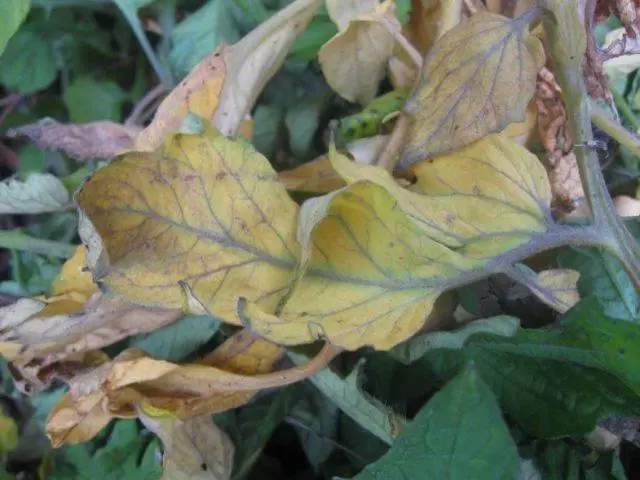
Most often, chlorosis is observed due to a deficiency of certain elements in the earth.
Nitric
If there is a lack of nitrogen in the soil, then chlorosis is called nitrogen chlorosis. Usually it is manifested by yellowing of the leaf plates. At the initial stage, the color of the veins changes, but if treatment is not started in time, the leaves turn completely yellow. In addition, the bushes stop growing, bloom worse, the ovaries form poorly. Treatment of the disease is carried out with nitrogenous top dressing, which is advisable to make before the second half of July.
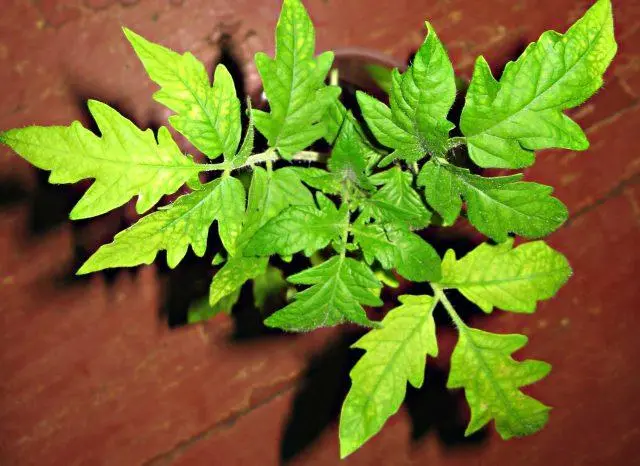
The development of nitrogen chlorosis originates in the lower part of the plant
Magnesium chlorosis of tomato leaves
With a lack of magnesium, the leaves turn yellow only along the edge, while their base continues to be green. Plants wither, dry out, shed their leaves, and yields drop. The fight against magnesium chlorosis on tomatoes (photo below) is carried out by reducing the application of nitrogen fertilizers, as well as additional fertilizing with magnesium sulfate.
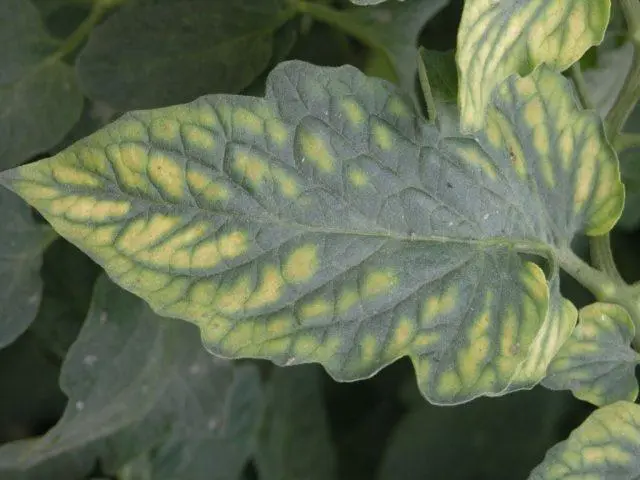
Magnesium deficiency symptoms can appear on old and young leaves.
Iron chlorosis of tomatoes
With an insufficient level of iron in the soil, tomatoes are affected by iron chlorosis. It usually appears on bushes that grow in alkaline soil (pH over 7) or on poor soil. You can identify the disease by yellow sheets with green veins.
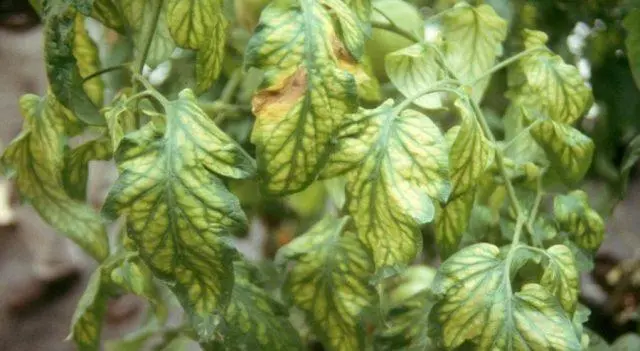
Iron deficiency of tomatoes often occurs when the area is excessively limed.
Sulfuric
Sulfuric chlorosis appears on young tomato leaves. First of all, the veins turn yellow, then, if treatment is not carried out, the color of the underlying tissue changes. If the disease is started, then the shade of the plates may become reddish. With a lack of sulfur, tomato stalks become thin, hard, brittle, develop slowly, and break easily.

Lack of sulfur slows down metabolic processes occurring in tomato bushes
Zinc
Zinc chlorosis can be recognized by yellow-cream spots on the green mass of the crop, as well as by the slow growth of foliage and its crushing. If not treated, tomato bushes will lose their resistance to drought and heat, and will also begin to suffer from fungal and bacterial diseases.
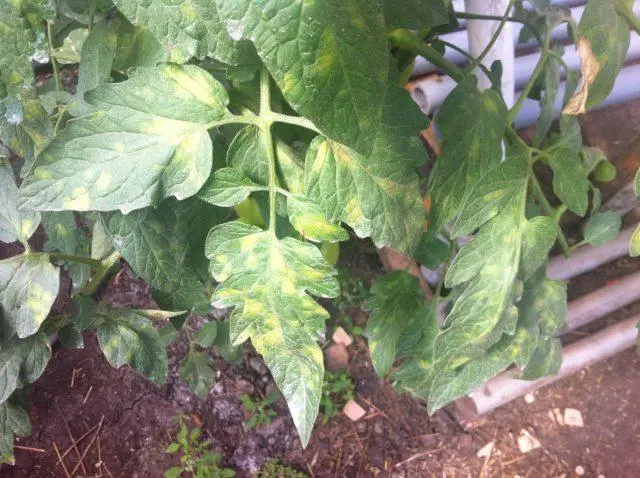
Veins of leaf plates with a lack of zinc remain green
Infectious chlorosis of tomatoes
In addition to the fact that there is non-infectious tomato chlorosis, there is also its infectious type, the causative agent of which is viruses that develop in plant cells. It usually spreads to shrubs from contaminated soil or through dirty garden tools. With this type of ailment, yellow vague blotches appear between the veins of the leaves. At first they can be seen on old plates, then they appear on young foliage.
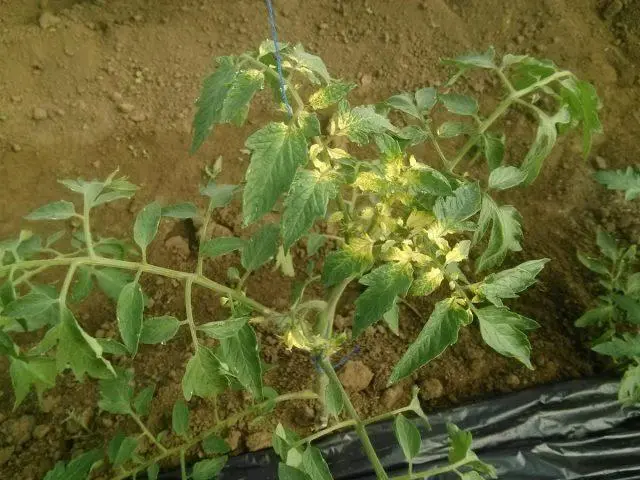
Infectious chlorosis causes drying and death of the tissues of tomato bushes.
Causes
The treatment scenario is chosen based on the causes of tomato chlorosis, as they vary depending on the type of disease. The yellow color of leaf plates and their veins can be caused by:
- high levels of soil acidity;
- moisture stagnation and poor drainage;
- alkalinity of the earth;
- poor environmental conditions;
- damage to the root system;
- dense landing;
- fungi and viruses.
How to get rid of chlorosis on tomatoes
Treatment of the disease is carried out when it is caused by non-infectious causes. If chlorosis appeared due to viruses, then trying to get rid of it is pointless. It is recommended to immediately dig up all the tomato bushes and burn them.
Additional fertilizing
Since the main reason for the appearance of a non-infectious type of disease is the lack of any elements in the soil, its treatment is organized by fertilizing. But before that, it is important to carefully examine the bush and, depending on how chlorosis looks on tomatoes, determine which substance is recommended to be added.
The following solutions are usually used:
- If the culture lacks nitrogen, it is fed with urea, ammonium sulfate, ammonium nitrate, urea. In summer, with this type of chlorosis, treatment is carried out with ammonia (15 g per bucket of water).
- In case of magnesium deficiency, wood ash is used. To do this, 1 kg of the product is dissolved in 10 liters of warm water, filtered and diluted in a ratio of 1:10. 1 liter of top dressing is spent on a bush. In the case of acidified soil, dolomite flour is added to watered beds at the rate of 25 g per square meter. Also, with magnesium chlorosis, spraying tomatoes with magnesium sulfate or potassium magnesia helps.
- With iron deficiency, treatment is carried out with a mixture prepared from 1 liter of water, 4 g of iron sulfate and 2,5 g of citric acid. Some gardeners make up for the lack of an element by digging rusty nails into the ground.
- Treatment of tomatoes affected by sulfuric chlorosis is carried out with a solution of 10 g of magnesium sulfate diluted in a bucket of water. In the spring, the beds are fertilized with diammophos or azophos.
- In case of zinc deficiency, plantings are watered with a product prepared from 5 g of zinc sulfate diluted in 10 liters of water. If the beds are located on the street, and not in the greenhouse, the dose of the substance can be doubled and sprayed on the bushes.
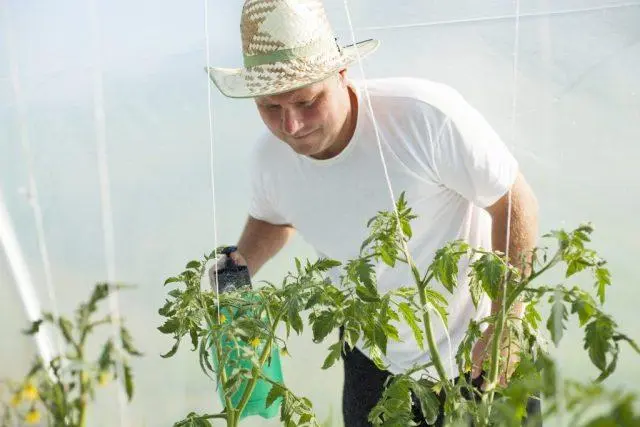
Before choosing a top dressing for tomatoes, it is advisable to conduct a study of the composition of the soil
Other treatments
The disease mainly occurs due to improper organization of agricultural technology. Therefore, its treatment is carried out by secondary methods, namely:
- reduce watering, which swamp and acidify the soil;
- more often loosen the beds, preventing the formation of a crust on the surface of the soil;
- normalized and nitrogen fertilizers are applied only in spring.
Photo and treatment of tomato seedling chlorosis
Not only adult tomatoes, but also seedlings are affected by chlorosis. The causes and treatment of a non-infectious disease are similar, they eliminate the disease in a standard way.
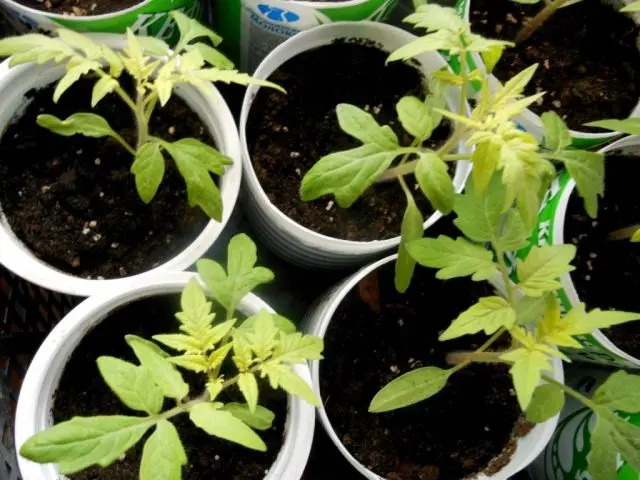
After a disease, seedlings do not always grow healthy and produce a crop.
preventive measures
In order to prevent the development of the disease and not to treat already diseased tomatoes, as a preventive measure, it is recommended to properly care for plantings:
- monitor the quality of drainage;
- control the pH level of the earth;
- periodically loosen the beds;
- observe the irrigation regime;
- timely carry out top dressing with complex fertilizers.
To exclude the occurrence of infectious chlorosis, you should always use sterile equipment when working and plant tomatoes on uninfected fertile soil.
Conclusion
The causes and treatment of tomato chlorosis depend on several factors. In particular, the disease manifests itself where the soil does not meet the requirements of the plant. If you plant tomatoes in a favorable place, take good care of them and take preventive measures, the disease is unlikely to make itself felt.










